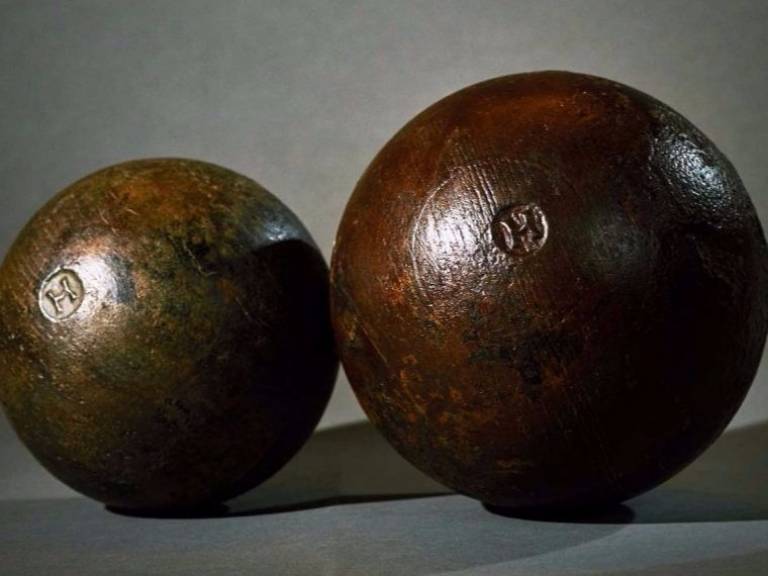Going ballistic! Science meets conservation on The Mary Rose
9 March 2018
Major advances into how to protect and preserve a huge haul of cannonballs found on Henry VIII's flagship vessel The Mary Rose, have been made through a ground-breaking partnership between UCL, The Mary Rose and Diamond Light Source.

The Mary Rose is a famous Tudor ship that sank in 1545 and was raised from the sea in 1982, when 1,200 cannonballs were discovered. The cannonballs have been at risk of disintegrating because chlorine in seawater is very damaging to iron, particularly when exposed to air. The combination causes corrosion that eats away at the metal and weakens its structure.
Initially researchers attempted to remove chlorine from the cannonballs, but this did not successfully prevent disintegration when they were put on display. To better understand this, Dr Eleanor Schofield, Head of Conservation at the Mary Rose Trust, established a research project working with PhD student Hayley Simon, from UCL Archaeology and Diamond Light Source, to understand what was going on inside the cannonballs.
"We wanted to find a way to preserve the cannonballs for future generations to come. Through understanding how the different treatments interact with the cannonballs, we can develop new treatment techniques that will allow these important artefacts to be displayed for the public to see," said Hayley Simon (UCL Archaeology).
The research group applied various conservation methods to the cannonballs to identify which method works best. Building on that research, the team has now used a powerful X-ray facility called Diamond Light Source, in Didcot, Oxfordshire, which allows them to measure the differences in the corrosion profiles and trace them to the treatments applied.
This exploratory process to identify which conservation method works best has involved detailed study of 12 of the 1,200 cannonballs. After consulting with Mary Rose curators, the decision was made in 2016 to cut segments from 6 of the 12 cannonballs, some of which were showing signs of damage, in order to save the rest.
"This is conservation science at its most cutting edge. We have taken just 12 of the cannonballs - less than 1% of the Mary Rose's stock but enough to provide statistical validity of our findings - to investigate different methods of conservation through synchrotron science," said Dr Schofield (The Mary Rose).
"Our cannonball sample is unique in that they were all raised from the sea at the same time, made at the same time, and are of very similar construction as only one iron blast furnace existed in Britain at the time of the Mary Rose's construction. This means that once we've found the solution, then the cannonballs can be preserved for generations to come and the science made available globally to all of those whose conservation work involves maritime or iron-rich artefacts," added Dr Schofield.
Results from the bright X-rays have revealed detailed maps of the elements involved in the corrosive process. This allows an unprecedented insight into conservation on a molecular scale. This is crucial information that will help protect this cultural heritage for many decades to come.
"These results represent a first step towards the development of new protective techniques. We are launching a long duration experiment next, which will observe changes in the corrosion product during long-term immersion in various conservation treatments to monitor their effects," said Hayley Simon.
"High quality science on archaeological artefacts frequently requires a sample to be taken, as this is the only way we can get the accuracy that we need. These excellent results were only possible because of the foresight of the Mary Rose Trust in allowing material to be removed from a small number of the cannonballs." said Ian Freestone, Professor of Archaeological Materials (UCL Archaeology).
Links
- News story source: Mary Rose
- The paper was published in Angewandte Chemie
- Hayley Simon's profile
- Professor Ian Freestone's academic profile
- UCL Institute of Archaeology
Image
- Source: Mary Rose
Media contact
Natasha Downes
Tel: +44 (0)20 3108 3844
Email: n.downes [at] ucl.ac.uk
 Close
Close

